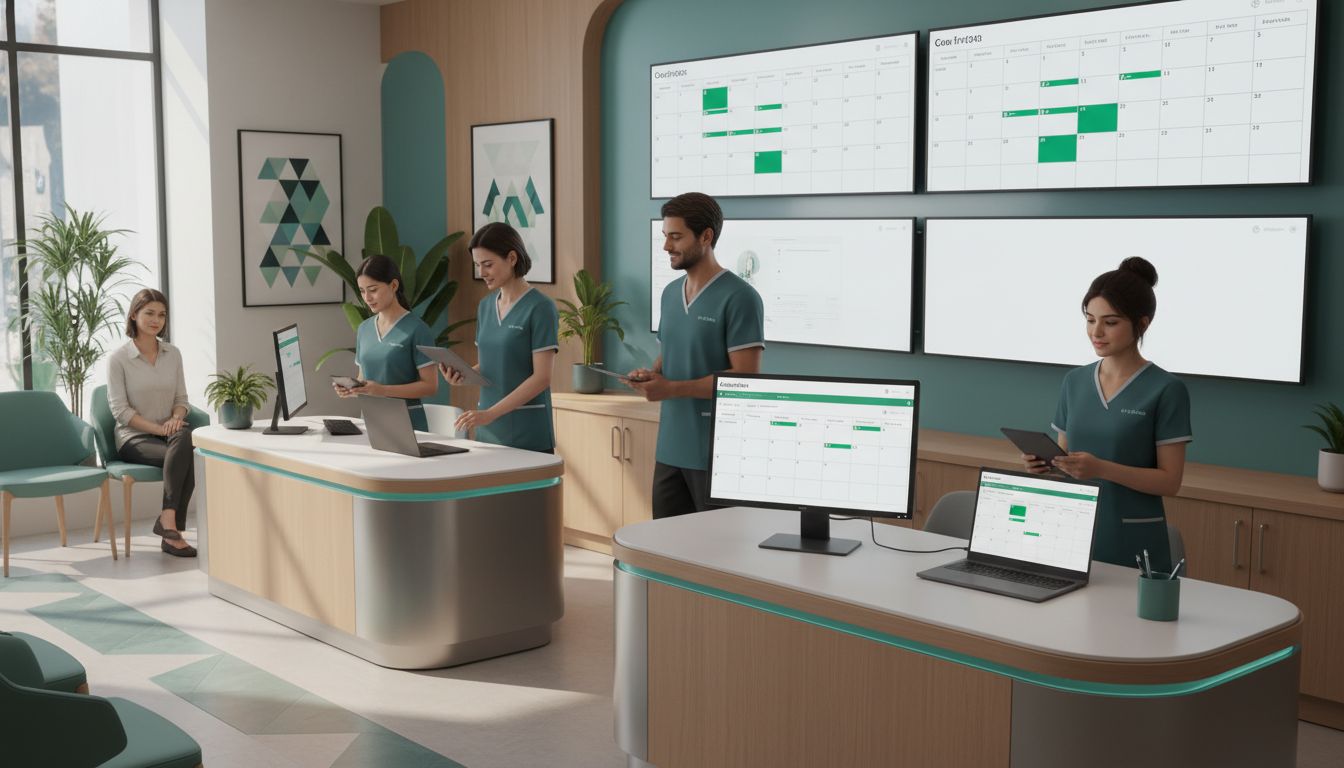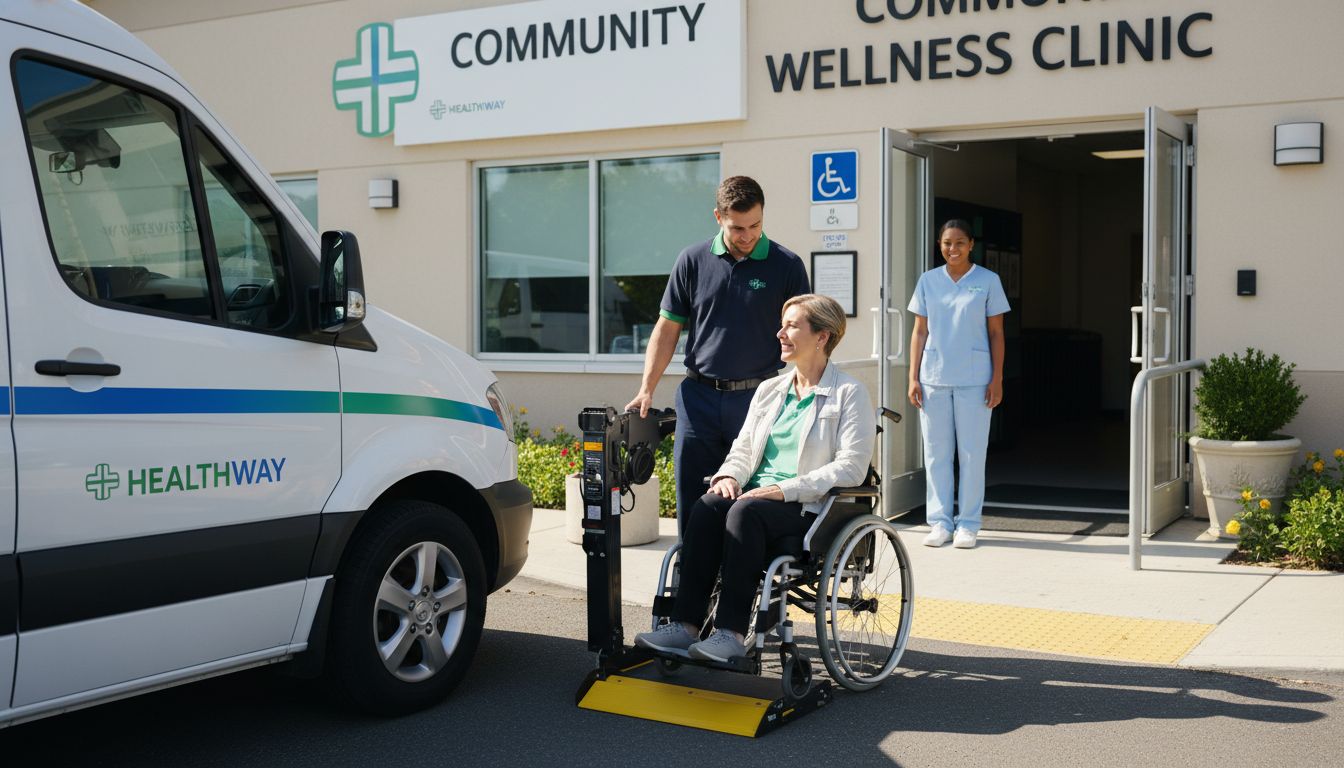Digital Transformation in Healthcare: Trends, Benefits, and 2025 Outlook
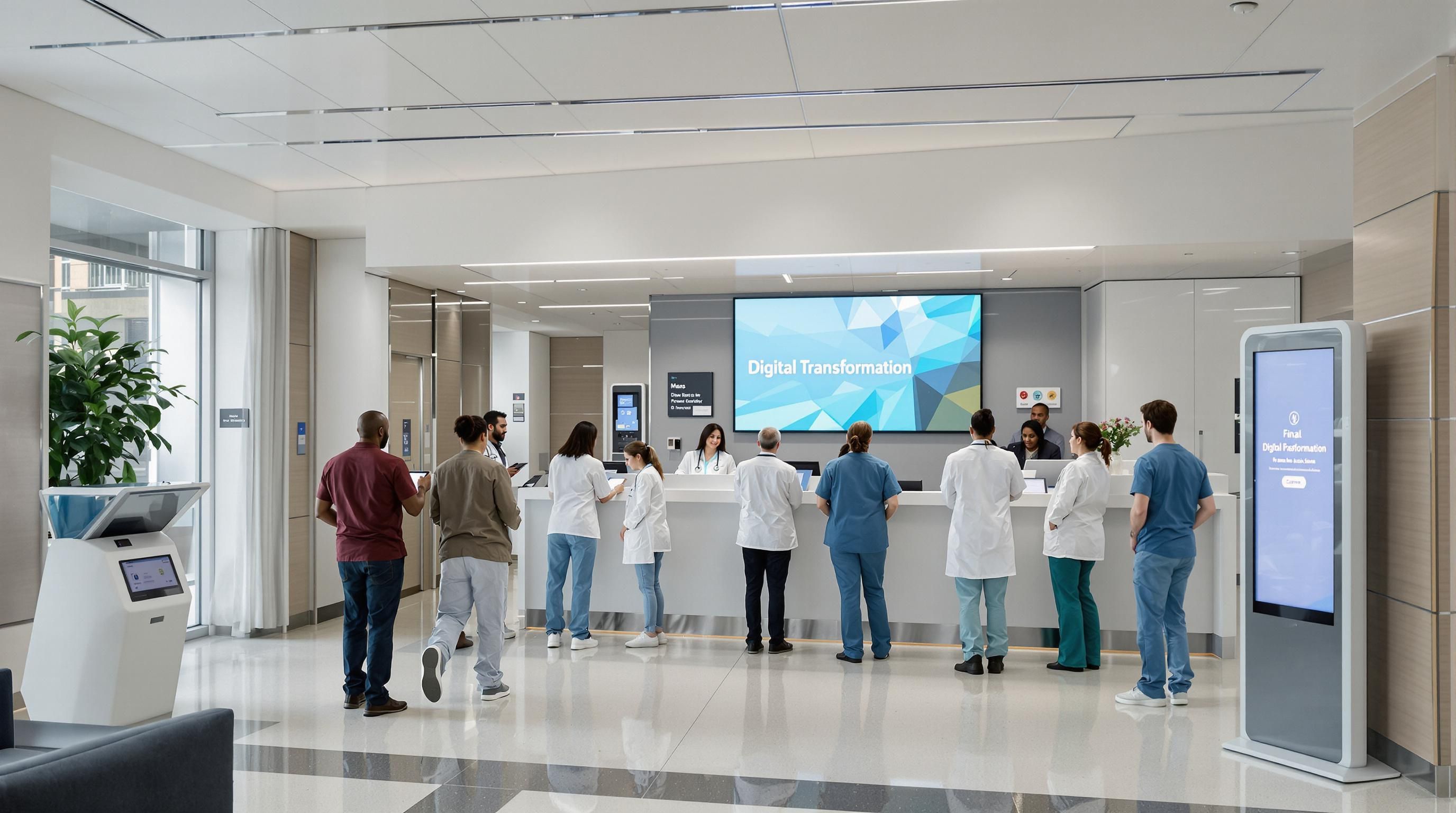
Healthcare is undergoing a massive shift as technology steps into every corner of patient care and operations. It might sound impossible but over 70 percent of healthcare providers are already using AI to enhance clinical decision-making. Now here is what most never expect. The biggest wins are not the cutting-edge gadgets but the way digital tools are breaking down old barriers and reshaping how humans connect, recover, and thrive in ways that numbers alone cannot predict.
Table of Contents
- Key Drivers Of Digital Transformation In Healthcare
- How Technology Is Improving Patient Care And Operations
- Challenges Facing Healthcare Organizations In 2025
- Future Trends For Providers And Emergency Services
Quick Summary
| Takeaway | Explanation |
|---|---|
| Digital transformation reduces costs and inefficiencies | Healthcare providers are leveraging digital solutions to streamline operations, minimize administrative burdens, and improve patient management. |
| Patient expectations are driving technological adoption | Patients demand accessible, personalized care; this necessitates the integration of advanced technologies for better healthcare delivery. |
| AI enhances clinical decision-making | Advanced AI systems significantly improve diagnostic accuracy, enabling personalized treatment plans and reducing errors in patient care. |
| Training is essential for successful implementation | Healthcare organizations must address digital skills gaps among staff to effectively utilize new technologies and ensure smooth integration. |
| Predictive care models improve patient outcomes | Technologies like wearable devices enable continuous monitoring and proactive interventions, particularly for high-risk patients. |
Key Drivers of Digital Transformation in Healthcare
Digital transformation in healthcare represents a profound technological and operational revolution driven by multiple interconnected factors. The healthcare industry is experiencing unprecedented change as technological capabilities, patient expectations, and systemic challenges converge to create urgent needs for innovation.
Rising Healthcare Costs and Operational Inefficiencies
Healthcare systems worldwide are grappling with escalating costs and complex operational challenges. Research from the National Library of Medicine reveals that digital transformation is increasingly seen as a critical strategy to address these financial pressures. Administrative overhead, inefficient patient management, and fragmented care delivery systems consume substantial resources. Healthcare providers are turning to digital solutions that can dramatically reduce operational expenses while improving overall system efficiency.
The push for digital transformation is fundamentally about creating more streamlined, cost-effective healthcare delivery models. Automated workflows, intelligent scheduling, and integrated communication platforms can significantly cut administrative burdens. By implementing advanced technological solutions, healthcare organizations can reallocate resources toward direct patient care instead of bureaucratic processes.
Technological Advancements and Patient Expectations
Rapid technological innovations are reshaping patient expectations and healthcare delivery models. Patients now demand more personalized, accessible, and transparent healthcare experiences. Gartner’s healthcare technology research indicates that digital platforms enabling remote consultations, real-time health monitoring, and seamless information exchange are becoming standard expectations rather than premium services.
Advances in artificial intelligence, machine learning, and data analytics are providing unprecedented capabilities for predictive healthcare management. These technologies enable more accurate diagnoses, personalized treatment plans, and proactive health interventions. Healthcare providers who embrace these digital transformation strategies can offer more precise, efficient, and patient-centric care models.
Pandemic-Driven Digital Acceleration
The COVID-19 pandemic dramatically accelerated digital transformation in healthcare. Social distancing requirements and overwhelmed healthcare systems forced rapid adoption of telehealth, remote monitoring, and digital communication technologies. What might have taken years of gradual implementation was compressed into months of urgent innovation.
Healthcare organizations discovered that digital solutions not only ensured continuity of care during crisis periods but also offered long-term strategic advantages. The pandemic demonstrated the critical importance of flexible, technology-enabled healthcare delivery systems that can adapt quickly to unexpected challenges.
Explore our detailed guide on emerging healthcare technology trends to understand how digital transformation is reshaping patient care and operational strategies. These technological shifts are not just incremental improvements but fundamental reimaginings of healthcare delivery in the 21st century.
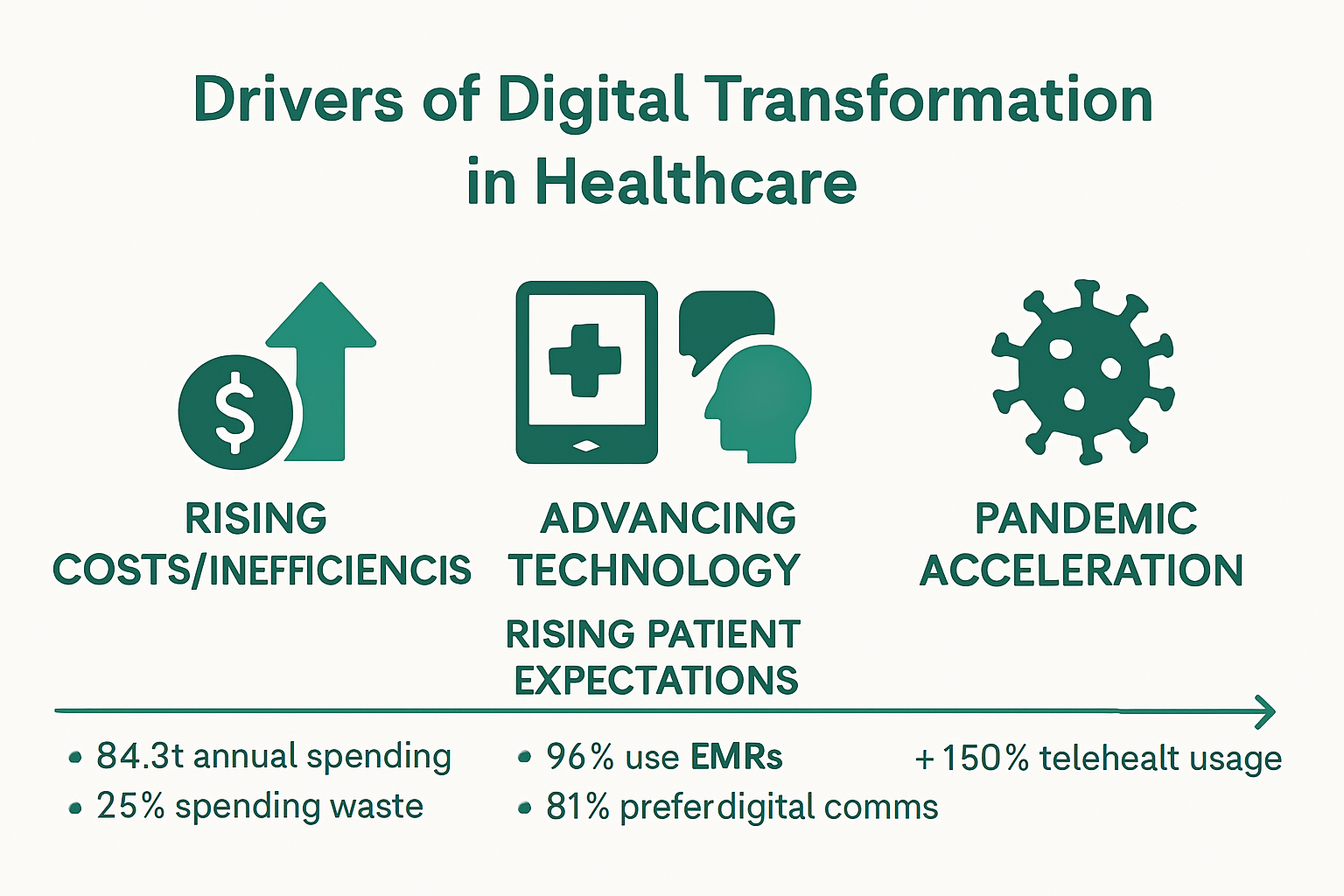
To help clarify the main drivers behind digital transformation in healthcare, the following table summarizes each driver and its impact.
| Driver | Description | Impact |
|---|---|---|
| Rising Healthcare Costs & Inefficiencies | Escalating costs, administrative overhead, and fragmented systems challenge healthcare providers. | Drives adoption of digital solutions to cut expenses and streamline operations. |
| Technological Advancements & Patient Expectations | Rapid innovation raises patient demand for personalized, accessible, and transparent digital experiences. | Pushes healthcare providers to invest in advanced tech for better care models. |
| Pandemic-Driven Digital Acceleration | COVID-19 forced rapid technology adoption (telehealth, remote monitoring) and urgent innovation. | Highlighted need for flexible, tech-enabled systems for resilience and continuity. |
How Technology Is Improving Patient Care and Operations
Digital technologies are fundamentally transforming healthcare operations and patient care delivery, creating more efficient, precise, and patient-centered healthcare ecosystems. These technological innovations are not merely incremental improvements but represent a comprehensive reimagining of healthcare service models.
Enhanced Clinical Decision Support and Diagnostic Accuracy
Research from the Journal of Medical Internet Research demonstrates how advanced health information technologies are dramatically improving clinical outcomes. Artificial intelligence and machine learning algorithms now provide sophisticated clinical decision support systems that analyze complex medical data with unprecedented speed and accuracy.
These intelligent systems can process vast amounts of patient information, medical history, genetic data, and current diagnostic imaging to generate highly nuanced diagnostic recommendations. Physicians can leverage these technologies to identify potential health risks earlier, develop more personalized treatment plans, and reduce diagnostic errors. Machine learning models continuously learn from new medical data, becoming increasingly accurate and predictive over time.
Streamlined Patient Flow and Operational Efficiency
JAMA’s recent healthcare technology analysis highlights how digital transformation is optimizing patient management and hospital workflows. Advanced scheduling systems, real-time patient tracking, and automated communication platforms are reducing administrative bottlenecks and improving overall operational efficiency.
Healthcare providers can now implement intelligent routing systems that match patient needs with appropriate resources, minimize wait times, and ensure more effective resource allocation. Digital platforms enable seamless communication between different departments, reducing potential information gaps and improving coordination of patient care. These technological solutions not only enhance patient experiences but also significantly reduce operational costs.
Personalized and Proactive Healthcare Delivery
Digital technologies are shifting healthcare from a reactive to a proactive model. Wearable devices, remote monitoring technologies, and advanced health tracking applications allow continuous patient health assessment. Patients can now receive real-time health insights, early warning signals about potential health risks, and personalized wellness recommendations.
Learn more about solving patient flow barriers and operational challenges and understand how digital technologies are revolutionizing healthcare delivery. These innovations enable healthcare providers to deliver more individualized, preventative, and responsive care models that prioritize patient wellness and operational excellence.
To illustrate the main ways technology is impacting patient care and operations, here is a summary table highlighting each improvement and its effects.
| Area of Improvement | Technology Involved | Effects/Benefits |
|---|---|---|
| Clinical Decision Support | AI, Machine Learning, Data Analytics | More accurate diagnoses, personalized treatments, reduced errors |
| Patient Flow & Operations | Real-Time Tracking, Automated Scheduling, Communication Platforms | Lower admin burden, better resource allocation, reduced wait times |
| Personalized & Proactive Care | Wearables, Remote Monitoring, Health Apps | Early detection of risks, individualized recommendations, proactive interventions |
Challenges Facing Healthcare Organizations in 2025
Healthcare organizations are confronting a complex landscape of technological, regulatory, and operational challenges as they approach 2025. These challenges demand strategic approaches that balance innovation, patient care, and systemic limitations.
Digital Skills and Training Gaps
Research from the European Susa project highlights a critical challenge facing healthcare organizations: the significant digital skills gap among healthcare professionals. Despite rapid technological advancements, many healthcare workers lack the necessary training to effectively utilize complex digital health technologies.
This skills deficit creates substantial barriers to digital transformation. Healthcare organizations must invest heavily in comprehensive digital literacy programs that go beyond basic computer skills. These training initiatives need to encompass advanced technologies like artificial intelligence, data analytics, and complex electronic patient record systems. The goal is not just technical proficiency but developing a culture of technological adaptability and continuous learning.
Regulatory and Interoperability Challenges
The Health Foundation’s comprehensive report reveals significant challenges in electronic patient record (EPR) implementation. Many healthcare systems struggle with incompatible technological platforms, creating information silos that impede efficient patient care and operational effectiveness.
Regulatory frameworks have not kept pace with technological innovation, creating complex compliance landscapes. Healthcare organizations must navigate intricate legal requirements while simultaneously implementing cutting-edge digital solutions. This requires sophisticated governance models that can adapt quickly to emerging technologies while maintaining stringent patient data protection standards.
Institutional Culture and Innovation Resistance
The Innovation Ecosystem Programme report identifies a profound challenge in healthcare digital transformation: institutional cultures that are inherently risk-averse and resistant to fundamental operational changes. Many healthcare organizations struggle to create environments that genuinely support technological experimentation and systemic innovation.
Overcoming this challenge requires leadership that can foster a culture of continuous improvement, psychological safety for technological experimentation, and strategic investment in emerging digital capabilities. Healthcare leaders must develop comprehensive change management strategies that address not just technological implementation but the human dimensions of organizational transformation.
Explore our guide on transforming credentialing challenges into organizational reliability to understand how healthcare organizations can turn potential obstacles into strategic opportunities. The path forward demands a holistic approach that integrates technological innovation, professional development, and adaptive organizational design.
Future Trends for Providers and Emergency Services
Healthcare providers and emergency services are poised for unprecedented transformation as digital technologies reshape traditional operational paradigms. The convergence of advanced technologies, data analytics, and patient-centered approaches is creating a new ecosystem of responsive, intelligent healthcare delivery.
AI-Powered Emergency Response and Triage
Research from the Journal of Medical Internet Research reveals that artificial intelligence is revolutionizing emergency medical services through sophisticated predictive and diagnostic capabilities. Advanced AI algorithms can now analyze complex medical data in real-time, enabling more accurate and rapid patient triage, resource allocation, and treatment prioritization.
Emergency services are increasingly leveraging machine learning models that can predict potential health emergencies, assess patient risk levels, and recommend optimal intervention strategies. These intelligent systems analyze historical medical data, current patient conditions, and broader epidemiological trends to provide nuanced recommendations that augment human medical decision-making. The result is a more proactive, precise approach to emergency medical response that can potentially save critical minutes during life-threatening situations.
Integrated Digital Communication and Coordination Platforms
The future of emergency services and healthcare providers lies in seamless, interconnected digital communication systems. Advanced platforms are emerging that enable real-time information sharing across multiple healthcare stakeholders, from ambulance services and emergency rooms to specialized treatment centers and rehabilitation facilities.
These integrated digital ecosystems allow for instantaneous patient data transmission, enabling healthcare teams to prepare for incoming patients, understand their medical history, and develop preliminary treatment plans before a patient even arrives. Advanced routing algorithms can now match patient needs with the most appropriate medical resources, reducing response times and improving overall patient outcomes.
Predictive Healthcare and Remote Monitoring
Healthcare providers are transitioning from reactive to predictive care models, particularly for emergency and high-risk patient populations. Wearable technologies, internet-connected medical devices, and advanced monitoring systems now provide continuous health data streams that can anticipate potential medical emergencies before they occur.
For emergency services, this means the ability to intervene proactively, monitoring high-risk patients and deploying resources precisely when and where they are most needed. Chronic disease management, elderly care, and trauma prevention are becoming increasingly sophisticated through these predictive digital health technologies.
Learn more about reimagining emergency medical services in the post-COVID landscape and understand how digital transformation is fundamentally reshaping healthcare delivery. The future of emergency services and healthcare providers is not just about technological innovation, but about creating more responsive, intelligent, and patient-centered care ecosystems that can adapt to emerging healthcare challenges.
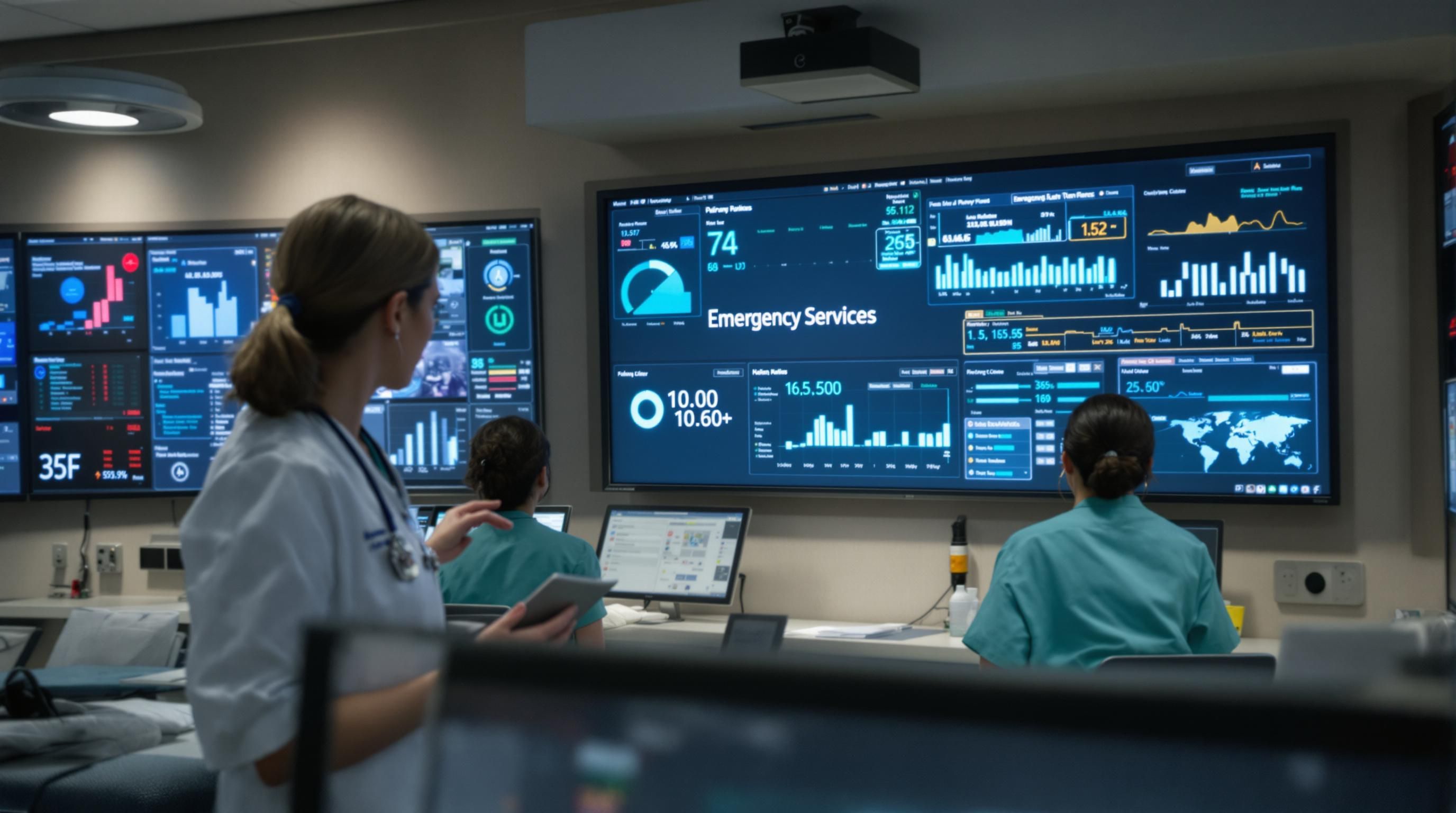
Frequently Asked Questions
What is digital transformation in healthcare?
Digital transformation in healthcare refers to the integration of digital technologies into all aspects of healthcare operations and patient care, driving improvements in efficiency, patient engagement, and outcomes.
How is technology improving patient care in the healthcare industry?
Technology is improving patient care by enhancing clinical decision-making through AI, streamlining patient flow with real-time tracking, and enabling personalized and proactive healthcare delivery through remote monitoring and wearables.
What are the main challenges healthcare organizations face in digital transformation?
Healthcare organizations face challenges such as digital skills and training gaps, regulatory and interoperability issues, and resistance to innovation within institutional cultures, impacting their ability to implement new technologies effectively.
What future trends can we expect in healthcare by 2025?
By 2025, expect trends like AI-powered emergency responses, integrated digital communication platforms, and predictive healthcare models that utilize remote monitoring to enhance patient care and operational efficiency.
Bring Your Healthcare Digital Transformation Goals to Life with Us
You have read how digital transformation is reimagining patient care, improving operational efficiency, and demanding new levels of interoperability in healthcare. Facing rising costs, fragmented systems, and stretched resources can be daunting for any healthcare provider. If you are searching for a proven way to streamline patient flow, reduce administrative burden, and connect every stakeholder with up-to-date information, there is an answer that delivers real results.
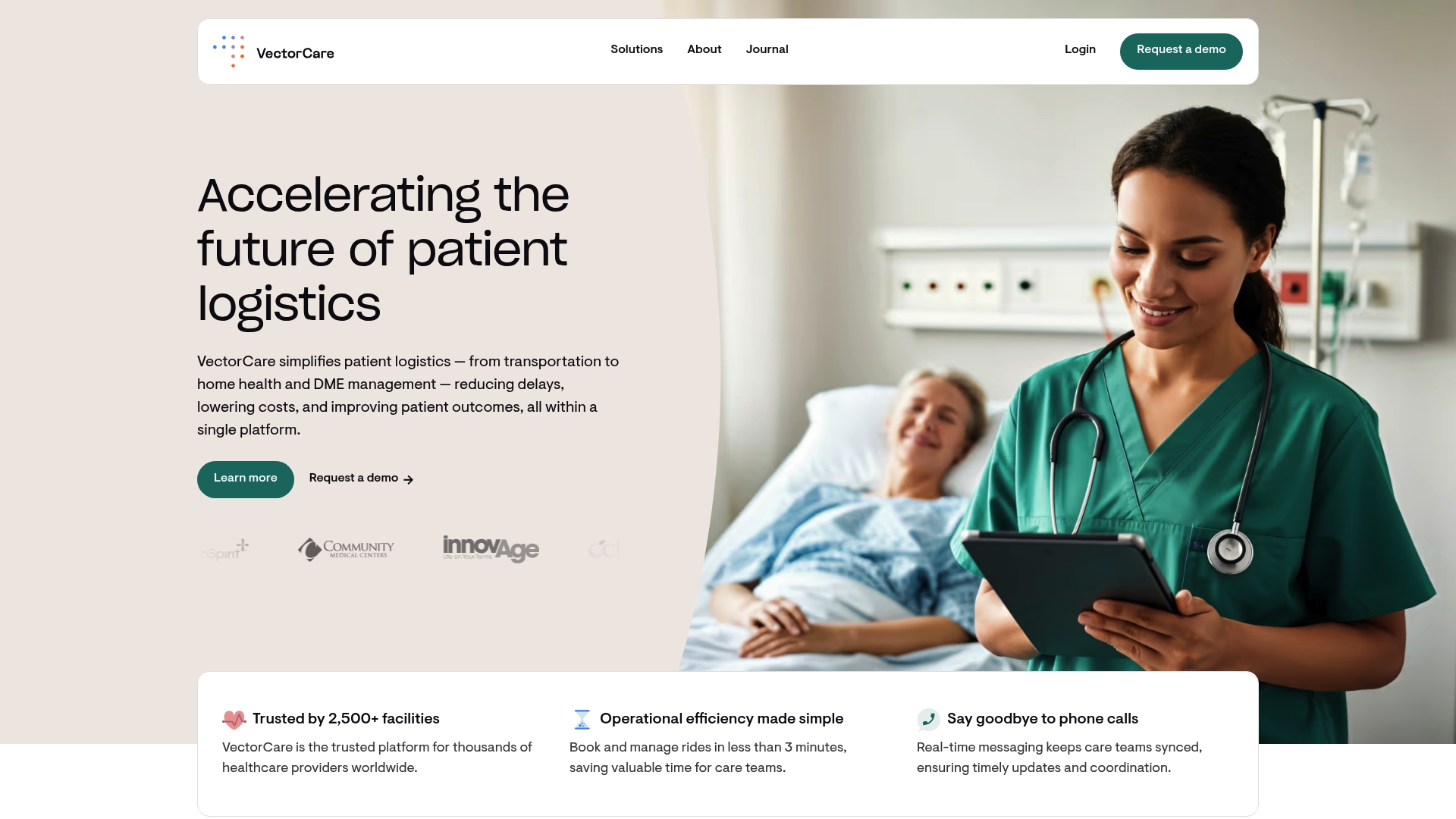
Discover how the VectorCare platform translates these digital strategies into measurable outcomes. Use automated scheduling tools, real-time updates, and AI-powered dispatch to eliminate delays and improve care coordination. Experience secure communication, vendor management, and actionable data insights all in one place. See how organizations are already reducing costs and avoiding wasted hours with our integrated, compliant solution. Visit our homepage now and start building a healthcare ecosystem where every patient touchpoint is faster, safer, and more reliable. The future is here—do not wait to make it yours.
